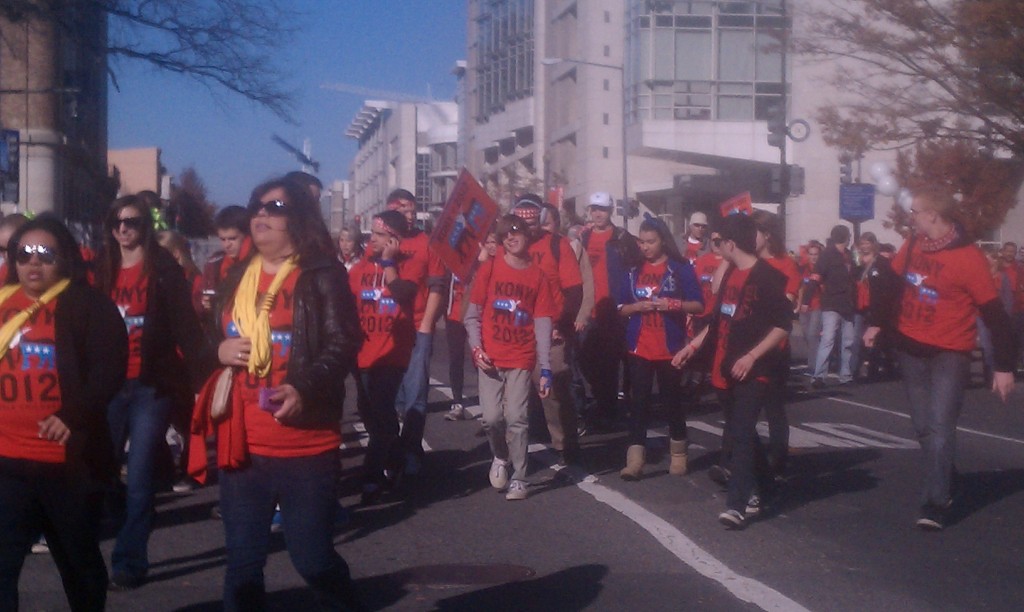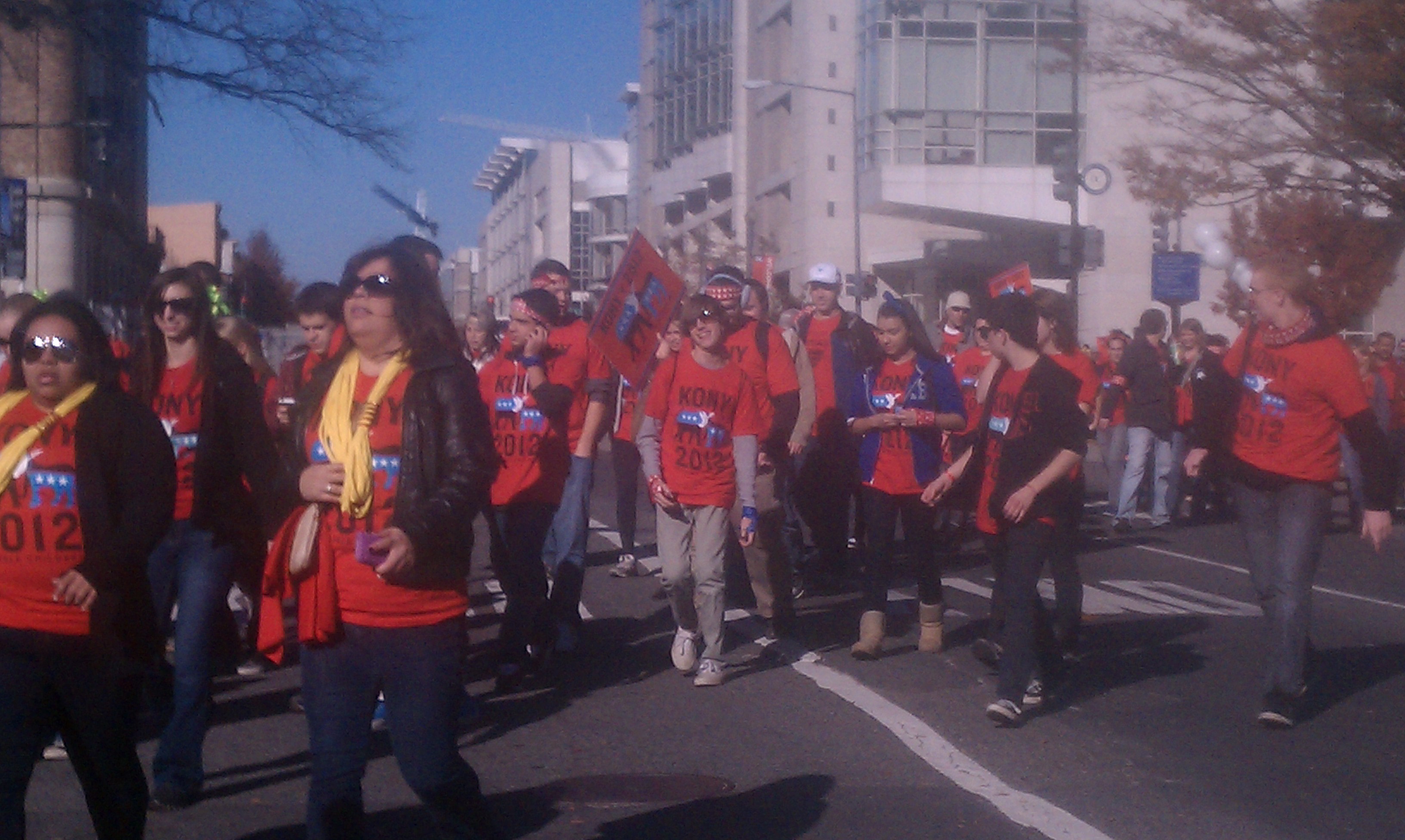As my friend, her babies, and I were walking home from the Botanical Gardens on Saturday, we were unable to cross the street near our home. Scores of red-shirted young people flowed out of the doors of the Washington D.C. Convention Center and onto New York Avenue. You may have guessed it (see pic below):

Although the march garnered no local or national media attention that I could find (though this run-up piece appeared in Non-Profit Quarterly), I realized that in my new position as a communicator, I am looking at this thing through somewhat of another lens now. What made this campaign so successful? The video so viral? And what turns out a reported 12,000+ young people (on the IC website), eight months after the founder’s very public breakdown?
I was reminded of this smart piece written by Riona McCormack on comminit.com, which I share below.
***
Lessons learned from KONY2012
Love it or hate it, the online phenomenon that is KONY 2012 offers valuable lessons to development communicators.
Never has a video – and certainly not one created by an NGO – generated such heated and conflicting responses, or achieved such global reach. Fast approaching the 100-million-viewer mark, in the week since the campaign’s launch, coverage of “KONY 2012” infiltrated every major news outlet and online forum, and ignited a storm of commentary among Facebookers and Tweeters of all ages.
However, there is a side to this public debate that has been relatively under-explored: and that is the lessons for media and communications professionals, and specifically those of us working in the development sector.
Here are five simple lessons that we can draw from this campaign:
1) Emotion sells: Empathy, sorrow, joy, anger – these are the things that make us human, and motivate us to act, learn, or care. The KONY2012 campaign provides emotional resonance in abundance, and the success of this approach is evident. If we are honest, many of us probably felt at least a niggling worm of jealousy watching that YouTube counter climb into the millions. How many excellent, worthy causes have we been pushing for years, wishing for a response just like this? We learn from this, in terms of how we present our work. At the same time, these tactics, familiar from the film industry, have the dangerous potential to become a form of emotional pornography. We must be careful in how we employ this approach, so that we do not comprise our mission, or our ethics, in order to provoke a reaction. An example of a feel-good video that doesn’t ignore the agency of the people involved in order to inspire support is Mama Hope’s glorious celebration of connectivity, their “Stop the Pity. Unlock the Potential” Campaign.
2) Urgency equals action: Another key to the success of the campaign was the inherent sense of urgency woven into it. The video emphasises the “window of opportunity” that will soon close, the terrible suffering of children which must not continue. For the same reason, efforts to fundraise for earthquake relief funds and other sudden disasters or famines are radically more successful than for ongoing issues of malnutrition. How can we use this in our own campaigns? How can we make long-standing issues with no easy answer into a cause of immediate concern? The Girl Effect is a very slick example of how to introduce a sense of urgency into a long-term problem – education for girls.
3) People want to act (1): Once people care about something, they usually ask “so what can I do?” If there is no answer to this question, your audience may end up more cynical and apathetic than before. The KONY2012 campaign’s infectiously viral success is due to the clear, simple action it provided for ordinary people to take. Whilst the simplistic nature of this action (especially in the context of a highly complex, distant conflict) has been the subject of much of the criticism facing the campaign, there are many cases in which liking, tweeting or forwarding on a message would be a perfectly appropriate action to encourage. An example would be any of the number of campaigns to write to local representatives to get aid allocations increased, etc. There have also been great examples of creative actions that go beyond simply clicking a button – such as the inspired Movember moustache drive. Bear this in mind the next time you create your own campaign: don’t just inform, ask. Let’s transform viewers into activists. We might be surprised by the response.
4) People want to act (2): … because it’s worth repeating. We need to recognise that however dubious the message or methodology of the campaign, the millions of people who watched the video, forwarded it on, and bought “action packs” from Invisible Children were motivated by a genuine desire to make a difference. Yet how many of us have at one time or another bemoaned the apathy and ignorance of the vast, amorphous “general public”? Is this is an opportunity for all of us as development communicators to recognise that if we are failing to engage the public, perhaps we need to look at ourselves and how we are communicating?
5) We need debate, not derision: Many supporters of the KONY2012 campaign have said “at least it has started people talking.” And this is certainly true; some truly excellent pieces of investigation, satire and reflection have been published, including a gratifyingly large number of responses from Ugandans. However, much of the debate that took place was bitter, simplistic, and divisive – the detractors classifying supporters as ignorant and uninformed, the supporters calling the detractors pompous and cynical. Both ‘sides” in this debate were to blame for the lack of a balanced discussion. If you disagree with aspects of the KONY2012 campaign, alienating those who support it will not change their viewpoint, nor will it encourage them to read more, learn more and engage more critically with complex issues. How can we find a way to transform the desire to be of service, so evident in the KONY2012 campaign, into sustainable, well-thought out actions?
A well-known aid blog recently characterised the KONY2012 debate within the development sector as being between development communicators (“StopKONY”), who are awed by the innovative form of the campaign, and development programme staff (“STOP StopKONY”) who are appalled at its substance. But perhaps respecting the kind of success the KONY2012 campaign has achieved does not mean we must follow its example. Rather, we can take from it what is useful – and discard the rest.
The author wishes to express that the opinions in her blog are her own and not intended to represent her organisation.
***
D.C., being the small town that it is, I also bumped into GlobalGiving’s Movember team out celebrating their participation in a smart and creative campaign. K’s permanent mustache wins hands down! I wonder how many StopKony tattoos are out there?
***
Related Posts
Bigger Than Kony: Livetweeting an Open Discussion
Searching for Closure: A Kony2012 Postscript
Bad guys, good guys, and the people in between


We are enthusiastic because we are making change and we are ending a war. We didn’t just march that day. We held a global summit with leaders from around the world who will enact change and policy. I find it sad that onlookers believe that our activism only runs as deep as watching a video or marching in the streets. We have supported real action that is helping victims in the region and people in the region from becoming victims. It’s not as simple as watching us in the streets, you need to do research as well. I’m not asking you to do years of research as I have however looking into the different actions that are being done by invisible children, resolve and the united nations may make you realize that we understand the conflict isn’t simple, and we know a simple march wont change it but that’s why we do so much more. I challenge you to do some real concrete research into intervention policies and when I saw research I mean look up things that aren’t tainted by biases on either end.
The fight for Africa’s wealth is still underway. U.S. advocates must stay engaged and make sure that they are getting grounded information from the people in East Africa themselves. See tools from Friends of Congo http://www.friendsofthecongo.org/
This news report from a showing of the Kony2012 video in Lira shows why: http://www.aljazeera.com/news/africa/2012/03/201231432421227462.html
Make sure you are listening to Ugandan voices first: http://www.youtube.com/watch?v=ARBIJD2PL18&feature=plcp
Thought-provoking and a delight to read. I remember when the KONY2012 campaign first took hold. I was visiting NY from LA where I was working at TOMS and so was already drowning with having to view “poverty porn.” I wouldn’t necessarily classify myself as being in the “STOP StopKONY” cohort, but I did roll my eyes and do my best to tune out anyone who went on an impassioned rant about what really “goes on in the world.”
The problem with communications in the development sector is that, in comparison with most commercial content–development is an intricate, complicated web of information. This doesn’t transfer well when it comes to standard communications and marketing practices. I think development practitioners responded so poorly partially out of envy, partially due to the substantive material–or lack thereof.
I now work on a comms team for a USAID microenterprise project and struggle with this everyday. What remains clear is that development communications simply cannot follow suit of traditional communications. It’s just too delicate a concept to be summed up by a slogan and some emotional images. The trick is figuring out how to achieve the effects we desire while recognizing the nature of the subject.